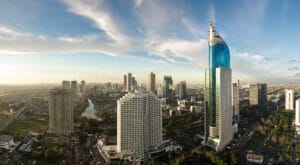As the world comes to grips with the new normal of a COVID-19-present world, protests have begun to spring up once again in numerous countries where citizens carry grievances. One such country has been Thailand which has seen demonstrations that began at the beginning of the year rekindle in the summer and continue to gain traction. This article will look at the causes behind the Thai demonstrations as well as how government forces and protesters have reacted and adapted to one another.
Originally established as an absolute monarchy, Thailand changed to a constitutional monarchy in 1932. The monarchy continues to enjoy high levels of political, legal and societal influence in the country, with ‘lèse-majesté’ laws making it illegal to ‘defame, insult, or threaten’ a member of the royal family; an offence which can carry a sentence of 15 years in prison.1 In this position of influence, the monarchy has been accused of facilitating the domination of the military in the country’s political landscape for years, a mutually beneficial arrangement which strengthens the reach of both.2 The political influence of the military has also played a hugely important role in Thai politics and is largely responsible for the country being on its 20th iteration of the constitution after a series of coup d’etats. The most recent of these coup’s occurred in 2014 when the democratically elected government was overthrown by General Prayuth, the now incumbent Prime Minister.3 Since King Maha Vajiralongkorn ascended to the throne a sequence of actions has increased the power of both the monarchy and the army, through the King’s consolidation of authority by bringing the wealth of the crown and key army units under his direct control.4 In addition to this, a new constitution pushed through by the military in 2017 significantly curtailed the power of political parties in parliament and allowed for an appointed senate; paving the way for another military victory in the 2019 elections, believed to be illegitimate by many.5
The political manoeuvrings by the crown and the military continue to erode the ‘constitutional monarchy’ Thailand purports to have, and represents the environment in which Thai citizens are protesting. This is further exemplified through the circumstances in which the demonstrations originated, with protests first appearing after the pro-Democracy Future Forward Party (who received the third-largest share of seats in the 2019 elections) were ordered to dissolve at the beginning of the year.6 Whilst the onset of the COVID-19 pandemic initially stopped the protests, July saw a reinvigorated movement take to the streets calling for a ‘real constitutional monarchy’.7 These renewed demonstrations also came with a more fully-formed agenda in which protesters are calling for the resignation of the Prime Minister (and architect of the 2014 coup); the rewriting of the constitution to give power back to the citizens; and the reformation of the monarchy, bringing it ‘under the purview of the constitution’.8
There have been several instances in the past in which demonstrations called for a reformation of the Thai political landscape, most notably in 1973, 1976, 1992 and 2010. All of these were responded to by the government with brutal force. The Council on Foreign Relations has pointed out that this is likely to happen in the latest round of demonstrations due to any meaningful reform around creating a truly constitutional and transparent monarchy ‘would badly damage the power of the king, and the power of the military that has as a primary objective upholding the monarchy’.9 Whilst not as brutal as previous crackdowns, glimpses of the government’s penchants for authoritarianism has been seen, particularly in the decision to invoke an emergency decree on 15th October. The introduction of the decree gave sweeping powers to the state such as banning the gatherings of more than four people, imposing a curfew, and instigating wide-reaching censorship curbing freedom of expression and freedom of the media. In addition to this, the decree also grants legal immunity to officials carrying out their duties and tactics such as the use of water cannons were reported to have been used against peaceful protesters, with reports of the water being laced with blue dye and teargas.10 Many human rights groups, including Human Rights Watch, have called the use of these tactics counter to guidance on ‘less-lethal weapons in law enforcement’ set out by the United Nations in 2020 which states that ‘water cannon should only be used in situations of serious public disorder where there is a significant likelihood of loss of life, serious injury or the widespread destruction of property’, neither of which was present upon application.11 12 To many the emergency decree was ineffective and, lasting only a week before being revoked, proved only to galvanise the masses shocked at the tactics employed by the government.13 It would also appear that Thai protesters have begun to adopt tactics first seen in Hong Kong, with the movement not only having no centralised leadership but also through the utilisation of hand signals and social media to coordinate, as well as to use equipment such as umbrellas, helmets and gas masks by those in demonstrations.14
One aspect of the demonstrations that could, at first glance, be considered unusual has been the role of Germany, with the German Embassy in Bangkok being a focal point of some demonstrations.15 These protests have also included the petitioning of the German government by Thai protesters to investigate whether the King has ‘conducted Thai politics using his royal prerogative from German soil or not’ where he reportedly spends the majority of his time, if this has occurred the German government has stated that ‘such action could be considered a violation of Germany’s territorial sovereignty’.16 17 18
It could be argued that precarious governments and political decisions have been able to hide behind COVID-19, with the virus being one such justification given by the Thai government when implementing the emergency decree. However, as the world adapts to the ongoing pandemic governments will find that they are increasingly less able to hide behind the virus as a justification of their decisions. Putting the pandemic to one side, in the case of Thailand, it would appear that both the government and protesters should look towards Hong Kong’s Umbrella Movement as a sign of what may come without reform. In order to avert this, arguably as the head of state, the King should, at a minimum, spend considerably more time in Thailand as a symbolic act and make a statement on the ongoing protests, which he has yet to do so, in order to restore the legitimacy of the monarchy. Further to this, obviously the optics of a former coup leader now acting as Prime Minister in a military-backed government is contentious and new free and fair elections may need to be considered. However, the seemingly intractable relationship between monarchy and military will likely ensure that the status quo will strive to be kept until there is no other option.


